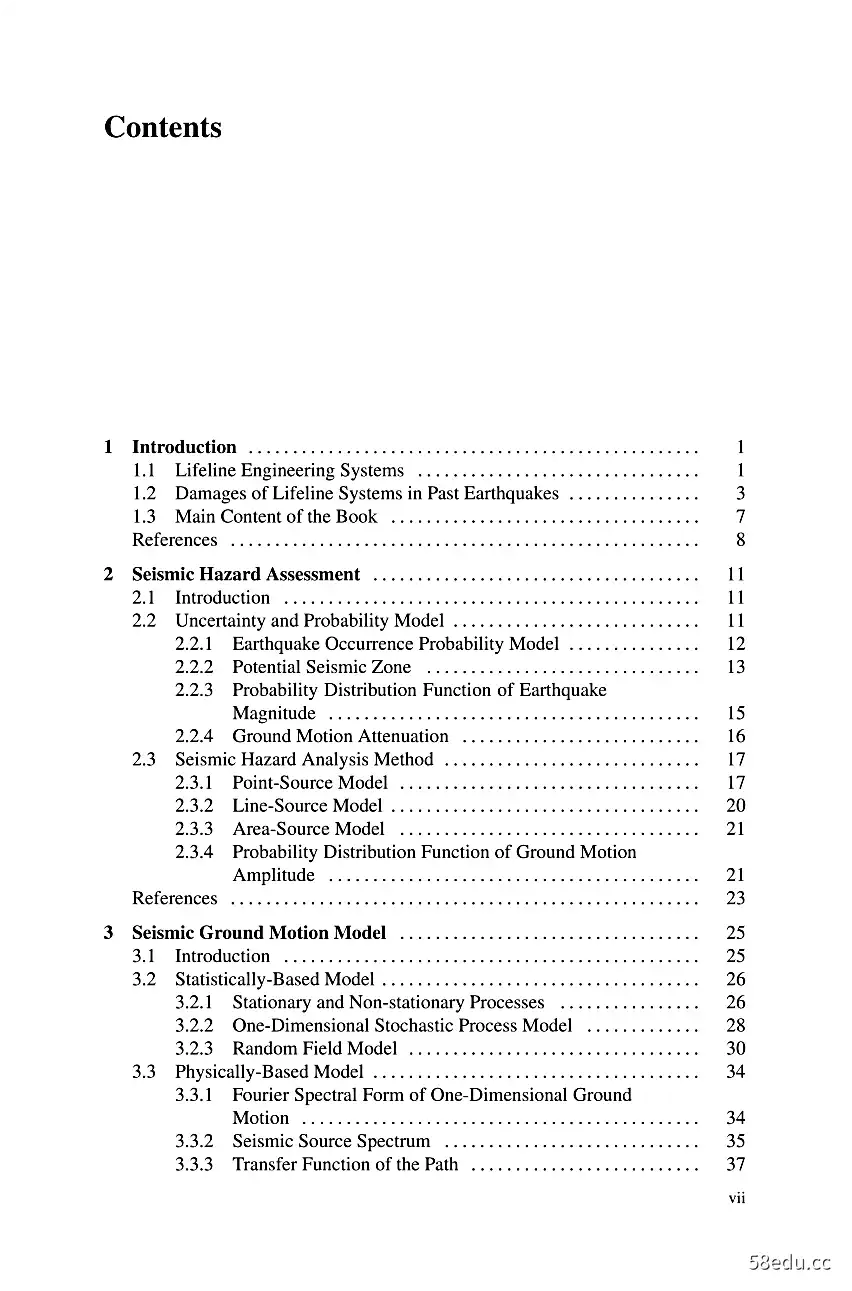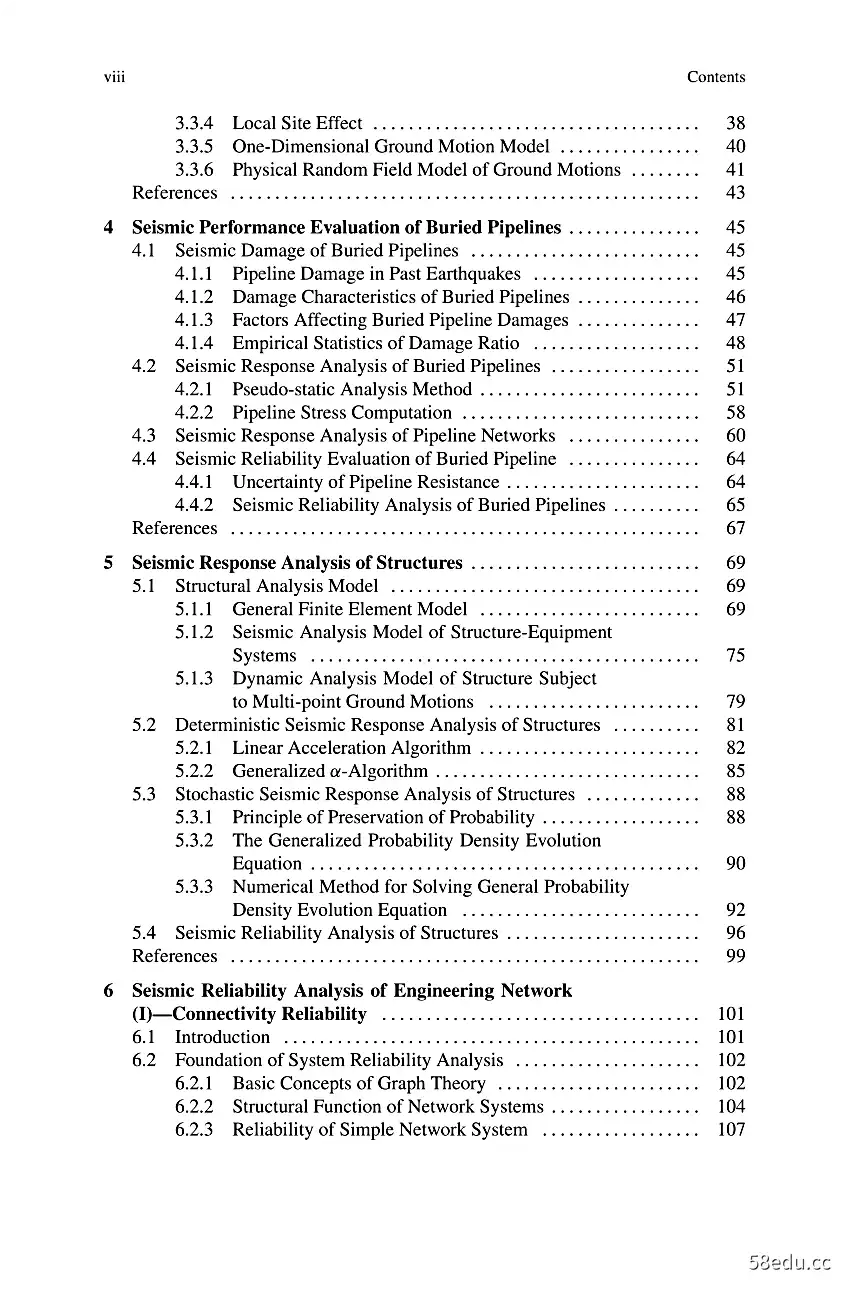《生命线工程系统 网络可靠性分析与抗震设计 英文版》李杰,刘威作|(epub+azw3+mobi+pdf)电子书下载
图书名称:《生命线工程系统 网络可靠性分析与抗震设计 英文版》
- 【作 者】李杰,刘威作
- 【页 数】 210
- 【出版社】 上海:上海科学技术出版社 , 2021.09
- 【ISBN号】978-7-5478-5416-7
- 【分 类】生命线系统工程-系统可靠性-系统分析-英文;生命线系统工程-防震设计-英文
- 【参考文献】 李杰,刘威作. 生命线工程系统 网络可靠性分析与抗震设计 英文版. 上海:上海科学技术出版社, 2021.09.
图书封面:

图书目录:


《生命线工程系统 网络可靠性分析与抗震设计 英文版》内容提要:
本书全面介绍了生命线地震工程的相关内容和最新研究进展,突破了传统研究思路中重结构轻网络,重连通轻功能、重分析轻设计的问题,构建了从结构分析到网络功能分析再到网络设计的研究思路,在国际上首次实现了生命线工程网络连通可靠度的高效精确的递推分解算法、地震下带渗漏工作供水网络功能可靠度的精细化分析方法、生命线工程网络抗震优化设计以及复合生命线网络建模和仿真。
《生命线工程系统 网络可靠性分析与抗震设计 英文版》内容试读
Chapter 1
Introduction
1.1 Lifeline Engineering Systems
Lifeline engineering systems,such as power systems,transportation systems,communication systems,water distribution systems,gas supply systems and soon,are essential to people's daily life.For modern society,such systems are theinfrastructure systems supporting the function of modern city and regional economy.
As infrastructure systems,lifeline engineering systems are generally featured byowning three important characteristics.Firstly,they distribute in a large area,such ashigh-voltage electrical networks,regional transportation networks and urban waterdistribution networks,distribute in a large area.As a result,their performance isdetermined not only by the basic elements but also by the topology structures ofthe networks.Therefore,system analysis is important for the lifeline engineeringsystems to understand their performance comprehensively.Secondly,lifeline engi-neering systems are composed of different structural elements,i.e.,engineering struc-tures.For example,for the electrical power systems,there are generally buildingsin power stations,high-voltage electrical equipment in transformer substations andhigh-voltage transmission towers in the transmission network.Similarly,roads andbridges in transportation systems and key buildings and equipment in communicationsystems are engineering structures as well.All these structures can be called as lifelineengineering structures.Their performance and operation states subjected to disas-ters determine whether the systems could maintain their functions or not.Thirdly,theperformance of a lifeline engineering system directly or indirectly exerts influence onthe other lifeline engineering systems.For example,whether electrical power systemswork well has great impact on the operation of urban water distribution networksin the same area.Similarly,whether the transportation and oil transmission systemswork well influences the operation of electrical power systems greatly.The inter-actions between different lifeline engineering systems become more apparent andextensive when serious disasters,such as strong earthquakes or hurricanes,happen.
Considering the interactions between different lifeline engineering systems,a set ofdifferent lifeline systems can be regarded as a composite lifeline engineering system.
Springer Nature Singapore Pte Ltd.and Shanghai Scientific and Technical Publishers 2021 1
J.Li and W.Liu,Lifeline Engineering Systems,https:/doi.org/10.1007/978-981-15-9101-31
1 Introduction
Certainly,other characteristics for different lifeline engineering systems can befound from different viewpoints.However,in this book only the structural char-acteristics of lifeline engineering systems are dealt with and therefore the othercharacteristics are not discussed.
The research on the disaster performance of lifeline engineering systems origi-nated from the mid-1970s.In 1971,during the San Fernando earthquake,the infras-tructure systems in San Francisco suffered serious damages.In the affected area,11power transmission lines and 47 highway bridges were destroyed,while more than600 pipeline breaks appeared on water and gas systems.Meanwhile,the malfunc-tions of electrical power,water distribution and transportation systems after the earth-quake attracted much attention (Duke Moran,1972).Based on the comprehensiveinvestigation on this earthquake,the concept of lifeline earthquake engineering waspresented and was accepted rapidly by the scientists and engineers (Duke Moran,1975).In 1974,a council,the Technical Council on Lifeline Earthquake Engineering(TCLEE),was founded in the American Society of Civil Engineers (ASCE).The firstlifeline earthquake conference was organized by TCLEE in 1978 and the conferenceproceedings was published (Technical Council on lifeline Earthquake Engineeringof ASCE,1977).In 1983,a World Lifeline Earthquake Engineering Conference wasorganized by the American Society of Mechanical Engineers (ASME)in Portland(Arima,1983).In 1984,during the 8th World Conference on Earthquake Engineeringin Japan,lifeline earthquake engineering was first listed as a session to exchange ideasbetween researchers and engineers.Since then,lifeline earthquake engineering hasalways been listed as a session in the later World Conference on Earthquake Engi-neering.Since 1990,Chinese,Japanese and American researchers on lifeline earth-quake engineering met every 4 years to hold the series China-Japan-U.S.Trilateral
Symposia on Lifeline Earthquake Engineering.
After nearly 50 years,the knowledge on lifeline engineering has been formulatedbased on a broader background.With the advancements of research and application,some new topics,including lifeline wind engineering,damage detection and healthmonitoring of lifeline systems,the resilience of lifeline system and so on,haveappeared.Now,the research on lifeline engineering is becoming an important drivingforce for modern civil engineering.
Generally,lifeline engineering systems can be defined as the infrastructuresystems which sustain proper operation and economic function of modern citiesand communities (Li,1999).This definition not only covers the previous research onurban lifeline engineering systems but also extends to regional lifeline engineeringsystems.
Considering the characteristic of research objective,a comprehensive investiga-tion on lifeline engineering should include three levels,lifeline engineering struc-tures,lifeline engineering networks and composite lifeline engineering systems.Theresearch of lifeline engineering systems would provide scientific science methodsand technical tools for modern lifeline engineering design considering performancein disaster scenarios and operational function in normal condition.
1.2 Damages of Lifeline Systems in Past Earthquakes
1.2 Damages of Lifeline Systems in Past Earthquakes
Among all kinds of natural disasters,strong earthquake is the biggest threat to life-line engineering systems.During one strong earthquake,almost all kinds of lifelineengineering structures would suffer serious damages.Worse than that,part of or evenall the functions of lifeline engineering systems will lose,including power cut,watersupply stoppage and cell phone out of service.In some extreme cases,the wholesystem function will lose even if only some key structures suffer lightly or mediumdamages because of the fragility of lifeline engineering systems.
During many previous strong earthquakes,a lot of lifeline engineering systemssuffered serious damages and lost their functions due to the strong earthquakes(Duke,1971;Liu,1986).Herein,the damages of some lifeline engineering systems areintroduced under strong earthquakes in recent 30 years.
1.American Loma Prieta Earthquake in 1989(ML 7.2)(EERI,1990)
During the American Loma Prieta Earthquake,taking place on October 17,1989,thedamage of the power system was a prominent phenomenon.The serious damages of230 and 500 KV high-voltage substations resulted in that over 1.4 million customersencountered power cut(Fig.1.1).In San Francisco,many robberies happened becauseof power cut.Meanwhile,over 350 pipeline breaks appeared in the water distributionnetwork and more than 1000 gas leakages appeared in the gas supply network.Manyoil tanks on soft soil ground were destroyed also.
Fig.1.1 Damage of high-voltage substations
1 Introduction
Fig.1.2 Damage of bridges
2.American Northridge Earthquake in 1994(ML 6.8)(EERI,1995)
During the American Northridge Earthquake,which happened on January 17,1994,the transportation system was partially paralyzed due to the serious damages of somebridges (Fig.1.2).Also,similar to the performance of the power system in American
Loma Prieta Earthquake,many 230 and 500 KV high-voltage substations sufferedserious damages.Moreover,a lot of high-voltage transmission towers collapsed dueto soil liquefaction under the earthquake.As a result,more than 1.1 million customersencountered power cut.During the earthquake,1400 pipeline breaks appeared in thewater distribution network of Los Angeles.Meanwhile,over 150,000 gas leakagesappeared in the gas supply network of Los Angeles,resulting in many fire accidents.
3.Japanese Kobe Earthquake in 1995 (ML =7.2)(Investigation Group of Kobe
Earthquake,1997).
The epicenter of the Japanese Kobe Earthquake,which happened on January 17,1995,located in a populous modern city.The investigation on the damages of life-line engineering systems caused by this earthquake was the most comprehensive onein the history.During the earthquake,5,438 people died and the direct economic losswas over 100 billion U.S.dollars.For the transportation system,six railroads crossingthe earthquake areas suffered serious damages and many viaducts collapsed.Among1,192 piers located in the highway from Osaka to Kobe,611 piers were damagedand the damage rate was around 52%.Among those damaged piers,about 150 pierswere destroyed and could not be repaired,which meant 13%piers should be rebuilt.
Also,many damages appeared on the subway.For example,the tunnel roof of the
Dakai subway station collapsed because the columns were damaged by shear force.
After the earthquake,a 120 m long ground surface sank and the deepest locationwas over 3 m in the station area(Fig.1.3).Also,Kobe Harbor was almost destroyed.
About 80%embankment was destroyed and some cracks on embankment were 3 mdeep.After the earthquake,one million customers encountered power cut and therepair process lasted 6 days.The damaged components of the power system included48 275 and 77 KV substations and 446 power distribution circuits.The economicloss caused due to the damages of the substations and the distribution circuits was
1.2 Damages of Lifeline Systems in Past Earthquakes
5
Fig.1.3 Surfacesubsidence due to thedamages of subway station
over 55 billion Japanese Yen and 96 billion Japanese Yen,respectively.Among 1.36million water customers in nine cities affected by the earthquake,including Kobeand Ashiya,1.1 million customers encountered water stoppage due to 1,610 pipelinebreaks in the water distribution network.A week later,only one third of the breakswere repaired.When the water distribution system recovered completely,two and ahalf months had passed.As a result,firefighting became very difficult due to lack ofwater.A newspaper report described the sad scene at that time,"firemen could donothing but just see the fire burning with tears."Meanwhile,gas supply systemsuffered serious damages and 5,190 gas breaks appeared.Among these breaks,109breaks appeared on medium-pressure pipelines.After the earthquake,857 thousandcustomers encountered no gas supply and the repair work lasted three months.For thecommunication systems,3,170 communication lines were damaged.19.7%commu-nication lines located in the south of Hyogo and centered in Kobe were cut off due tothe failures of telephone switchboards or the damages of communication lines.Manycommunication equipments were destroyed and some communication buildings wereout of service (Fig.1.4).
4.Chinese Taiwan Chi-Chi Earthquake in 1999 (ML 7.3)(Architectural
Institute in Taiwan,China,1999)
During the Chinese Taiwan Chi-Chi Earthquake happened on September 21,1999,2,444 people died and 11,305 people were wounded.The economic loss reached444 billion NT dollars.The transportation was disrupted in Central Taiwan,andmany bridges,including Mingzu Bridge,collapsed.The railway stations of Central
Taiwan and Chi-Chi suffered serious damages,including inflexion of rails and fall oftrain electrical lines.Meanwhile,due to the damages of the power system,5.2 millioncustomers covering a large area in the north and middle of Taiwan encountered powercut,resulting in a direct economic loss of 5.94 billion NT dollars.Also,the economiclosses of water conservancy facilities and water pipelines were 4.72 billion and 950million NT dollars,respectively.
6
1 Introduction
Fig.1.4 Damages ofcommunication tower
5.Chinese Wenchuan Earthquake in 2008(ML =8.0)(State Key Laboratory of
Disaster Reduction in Civil Engineering,Tongji University,2008)
On May 12,2008,a strong earthquake attacked Wenchuan in China.During the earth-quake,the lifeline engineering systems suffered serious damages.In the affected area,40 substations with 110 KV or higher voltage were damaged,resulting in that 180transmission lines were out of service (Fig.1.5).For gas supply systems,pipelines,equipments and other structures were damaged and the total number is as high as51,000.For water distribution networks,677 water factories and 138,000 km longpipelines were damaged in the affected area (Fig.1.6).Taking the water distributionnetwork of Mianzhu as an example breaks appeared on about 70%pipelines among47 km-long mains pipelines,especially the gray cast iron pipelines and prestressed
Fig.1.5 Damages of thepower substation
···试读结束···
作者:严小明
链接:https://www.58edu.cc/article/1521813391952326657.html
文章版权归作者所有,58edu信息发布平台,仅提供信息存储空间服务,接受投稿是出于传递更多信息、供广大网友交流学习之目的。如有侵权。联系站长删除。